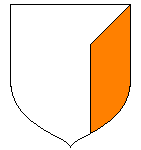Gusset: Difference between revisions
From Cunnan
Jump to navigationJump to search
m (links) |
m (Reverted edits by 74.208.11.169 (Talk); changed back to last version by User 144) |
||
| (4 intermediate revisions by 4 users not shown) | |||
| Line 1: | Line 1: | ||
==Gusset ([[Heraldry]])== |
==Gusset ([[Heraldry]])== |
||
[[Image:gusset.PNG|right]] |
|||
A '''gusset''' is a [[heraldic]] [[charge]] in the shape of a [[tierce]], with a wedge taken out of the top section. A gusset [[sinister]] is considered an [[abatement]] indicating drunkenness. |
A '''gusset''' is a [[heraldic]] [[charge]] in the shape of a [[tierce]], with a wedge taken out of the top section. A gusset [[sinister]] is considered an [[abatement]] indicating drunkenness. |
||
Latest revision as of 08:58, 10 November 2007
Gusset (Heraldry)
A gusset is a heraldic charge in the shape of a tierce, with a wedge taken out of the top section. A gusset sinister is considered an abatement indicating drunkenness.
Gusset (clothing)
A gusset is a small section of cloth, generally square, that is added to garment to allow a degree of movement. Typically they are found between an arm and the torso or between legs.
A large amount of early medieval clothing used this method in the construction of garments as it allowed a more economic use of fabric.
